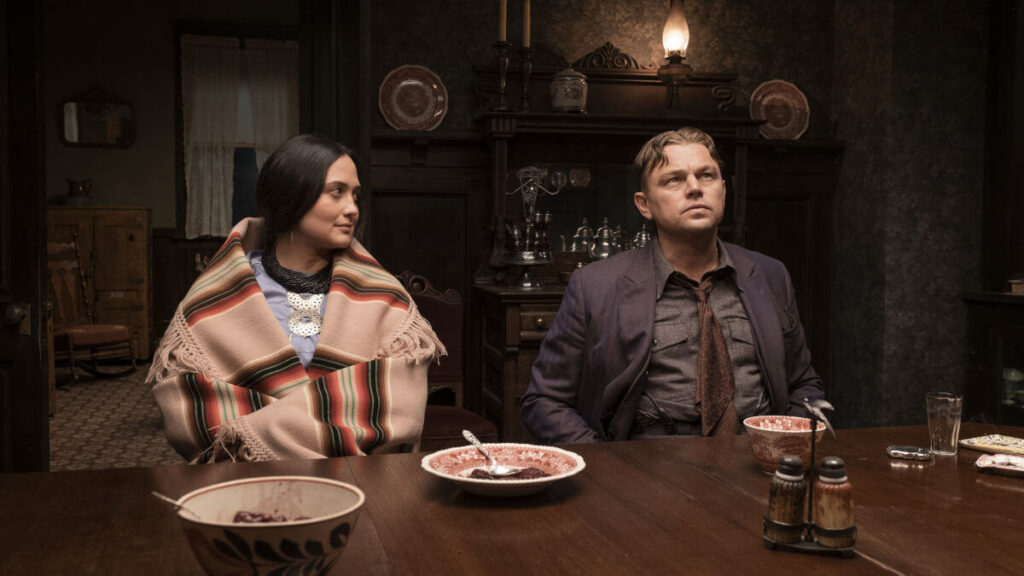The plot of Killers of the Flower Moon is rather simple: the shocking true story of the series of mysterious deaths of Native Americans from 1910s to 1930s in the oil-rich Osage Nation in Oklahoma.
Called the “Reign of Terror,” this horrific period in American history is marked by the uninvestigated murders of the Osage tribe — the richest people in the world per capita at the time due to the vast deposits of oil found in their reservation.
As black gold richly flows in their land, white men descend into the territory and begin to systematically murder the Osage tribe to steal their oil money, or headrights. Greed takes the form of grisly, nonchalant murders, compounded by racial injustice.
Director Martin Scorsese takes us to Fairfax 1920s, where one such greedy white man, Ernest Buckhart (Leonardo DiCaprio) arrives in the Osage county from a non-combatant role in World War I.
His guts destroyed in the war, he seeks a job from his uncle, King Bill (Robert de Niro), the powerful boss in the area and the mastermind behind the Osage killings but pretending to be a “friend to the Osage.”
King Bill tells his nephew to marry a beautiful Osage woman, Mollie (Lily Gladstone) in a scheme to get her headrights. The movie focuses on the “love story” of Ernest and Mollie, and how Mollie is slowly poisoned to death.
The colossal running time (3.5 hours) is barely felt. This epic revisionist Western drama is a visual spectacle and should be seen on the big screen to experience Scorsese’s glorious cinematic vision.
Scorsese adapted David Grann’s 2017 bestselling non-fiction book on this grim chapter in American history. I haven’t read Grann’s book, but research revealed that it’s chiefly a detective story, with the murders viewed from the lens of the newly formed Bureau of Investigation (now the FBI) headed by Tim White.
In The Irish Times interview with Scorsese, the director shared that he and co-writer Eric Roth initially wrote a script that was faithful to the book, with Scorsese’s muse, Leonardo DiCaprio, set to play White. But two years into the writing process, DiCaprio made a suggestion that completely overhauled the script, shifting the focus to Ernest (DiCaprio’s modified role) and Mollie.

Lacking momentum
The script often feels like it lacks momentum and depth, reducing Ernest and King Bill, and even Jesse Plemons as White, to stock characters. Roth is known for overhyped shallow films such as The Curious Case of Benjamin Button, Forrest Gump and Extremely Loud and Incredibly Close, so he’s partly to blame for the lack of insight into the psychology of the film’s fascinating characters.
Plemons came in too late into the show, nearly in the third hour. The film feels like it took its leisurely time to establish the greed and the machinations of the non-threatening King Bill, then realized it is getting too long and finally crammed the investigations into the last hour.
Punctuated with dark humor, the movie is crafted to entertain rather than to appeal to our sympathy. This feels rather conflicting and mildly disturbing, as the Osage, victims of greedy white men, and whose story is just now spreading into public consciousness, are merely the sideshow. If they were robbed back then, this film also robs them of central attention, choosing to focus instead on their killers, particularly DiCaprio, with a strong supporting role from Gladstone’s Mollie.
The Osage are also depicted as gullible and helpless, and we often crave to understand what goes on in their minds, which the movie does not really provide us.
But Scorsese’s films have always been from the POV of the criminals, and the title says it all — so perhaps it is unfair to expect a different narrative.
Compelling vision
Thankfully, Scorsese, despite the oftentimes frustrating script, manages to redeem the entire film with his compelling vision, orchestrating pure cinematic delight with the film’s stunning cinematography, production design and costume.
Despite the focus on the killers, he still redeems the Osage by showcasing, with reverence, their culture and pantheistic religion — their belief in the invisible world of Wah-kon-tah and eventual blend with Christianity.
The era’s racism and greed are also profoundly felt in the movie — from the white guardians that controlled the Osage money, to the insurance frauds they were subjected to and, most chilling of all, the calm way the whites murdered the Native Americans, as if these people were mere nuisances.
Di Caprio, with his fake sordid teeth, delivers, as always, a competent performance. But it is Gladstone, with her regal beauty and intelligent eyes, that truly shines in the film.
Killers of the Flower Moon, despite its imperfections, triumphs in fully immersing the viewer in its story and putting the spotlight on an important chapter in American history. It reminds us that theaters are still a necessity for this kind of epic movie experience.
3.5 out of 5 stars/
In cinemas
